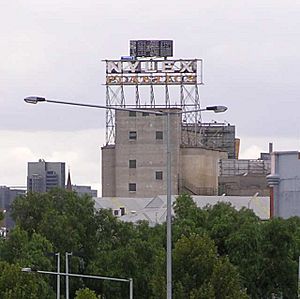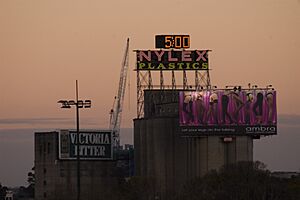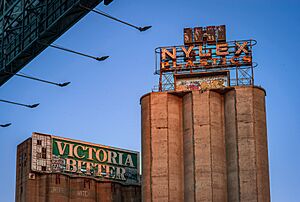Nylex Clock facts for kids
The Nylex Clock is a famous landmark in Melbourne, Australia. It's a bright neon sign sitting on top of tall storage buildings called silos. These silos are in a suburb called Cremorne, right next to the Yarra River. The clock shows the time and temperature, switching between them. It also flashes the words "Nylex Plastics" and then "Nylex Every Time!". Many people in Melbourne can see this clock, and it's a well-known part of the city's culture. It's even mentioned in a song by Paul Kelly called "Leaps and Bounds."
Some Australian hip-hop artists, Baker Boy and Dallas Woods, filmed their music video for 'Black Magic' at this site.
Contents
The Nylex Clock's Story

The Nylex Clock and its sign were built in 1961. A company from South Melbourne called Neon Electric Signs created them for Nylex, an Australian company that made plastic products. The clock sits on top of 20 silos, which were built in the 1950s and 1960s to store barley.
Protecting a Landmark
In 2002, there was a plan to build new offices on the land where the silos stand. The architects thought the silos weren't historically important. However, they agreed that the Nylex sign itself was very valuable and should be saved. This building plan was stopped in 2003 because people wanted to protect the site's history.
The Nylex Clock stopped working for several years. But in 2004, plans were announced to fix it. The sign was also added to the Victorian Heritage Register in March 2004, which means it's officially protected as an important historical item. The land around the silos was sold in September 2004.
Bringing the Clock Back to Life
On June 29, 2005, the Nylex Clock was turned back on at 7:24 AM. It was a big event, even broadcast live on a radio station! The restoration cost $300,000 and used 17,000 LED lights and lots of neon tubing and electrical cables. However, the time got stuck at 7:24 AM because of a small problem with its satellite connection.
Later in December 2005, the lights were changed to orange LEDs to make the clock easier to see.
Times When the Clock Stopped
The clock had a few more issues. In May 2006, it froze at 6:38 for several days. A special device was installed to prevent this from happening again. It broke down again in September 2006, but bad weather made it hard to fix.
In March 2009, the clock was switched off because the Nylex company faced financial problems. Since then, the clock and temperature display have not been working. People hoped the local council would take over the costs to keep it running.
In January 2015, a group called 'The Nylex Clock Collective' managed to turn the clock on briefly. Drivers noticed it was an hour behind because it hadn't been adjusted for daylight saving time.
Future Plans for the Site
In March 2017, plans were approved to build two new towers, 13 and 14 stories high, on the site. The developer, Caydon, had originally planned to knock down all the silos. But now, more than half of the original 1962 silos will be kept. The Nylex sign and clock were planned to be restored to working order. However, the landmark was put into storage during the construction, meaning it disappeared from Melbourne's skyline for a number of years.
In November 2017, a fire broke out in an old factory nearby, causing traffic problems. Firefighters worked for hours to put out the blaze.
Other Famous Signs
- Borsari's Corner in Carlton, Victoria
- Dingo Flour sign in North Fremantle, Western Australia
- Pelaco Sign in Richmond, Victoria
- Skipping Girl Sign in Abbotsford, Victoria



